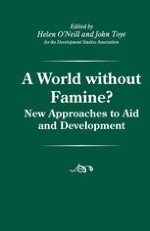1998 | OriginalPaper | Buchkapitel
Structural Adjustment and Drought in Sub-Saharan Africa
verfasst von : Ibrahim Elbadawi
Erschienen in: A World without Famine?
Verlag: Palgrave Macmillan UK
Enthalten in: Professional Book Archive
Aktivieren Sie unsere intelligente Suche, um passende Fachinhalte oder Patente zu finden.
Wählen Sie Textabschnitte aus um mit Künstlicher Intelligenz passenden Patente zu finden. powered by
Markieren Sie Textabschnitte, um KI-gestützt weitere passende Inhalte zu finden. powered by
Sub-Saharan Africa (SSA) has been affected by very frequent and severe droughts in the form of extreme rainfall variability and almost a secularly declining precipitation in the sizeable arid and semi-arid zones of the sub-continent.
2
It is estimated that as much as 60 per cent of SSA is vulnerable to drought and about 30 per cent is considered to be highly vulnerable (Clay, 1995). Because of the heavy dependence on extensive resource utilisation in the context of a technologically poor agriculture and substantially disarticulated economies, the human and socioeconomic impacts of these droughts have been quite substantial. A revealing account of the impacts of recent droughts in SSA is documented by Rasheed (1993):
the 1968–1973 drought in the Sahel caused more than 100,000 deaths, the loss of twelve million cattle, large-scale migration of herders and farmers and massive degradation of rangelands … The 1984–1985 severe drought in this zone and other regions claimed over 100,000 lives, caused famine among forty million people, displaced another ten million people and had a negative impact on the economies of many countries. The drought has not spared even the normally rain-bountiful Eastern and Southern African sub-region. The failure of rain in late 1991 and early 1992 caused the food harvest to drop by about half the levels of previous years, necessitated four million tons of food aid, and imports of over $200 million worth of emergency non-food aid, and caused the death of large numbers of livestock and wildlife, power cuts and the closing down of factories.’
3
